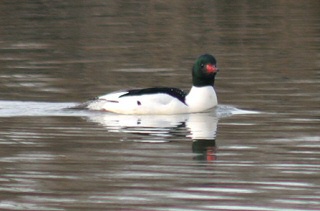|
Trail Guides
|
Carol Nicoletta Park - Shellbay Avenue Pier
|
6
 
|
End of Shellbay Avenue, Cape May Court House, NJ 08210
Phone: (609) 465-8732
Middle Township
Turn Left out of Lizard Tail Swamp parking area onto CR 657/Dennisville Road.
Follow Dennisville Road through the traffic light
at Route 9 and turn Right (southbound) onto the Garden State Parkway. Travel one mile and move into the Left lane. At Exit 9, turn Left onto
Shellbay Avenue. Follow Shellbay Avenue approximately 1⁄2 mile to parking area at end of road. Map
 |
| Male Common Merganser | Gary Baldwin |
| |
| | This park offers a scenic view of the backwaters of Jenkins Sound, including the salt marsh and forested edge. Two covered picnic areas are ideal for stopping for lunch or a snack while getting a glimpse of coastal waterfowl and shorebirds. You can walk down the pier, crab and fish during the summer, or launch your kayak for a paddle around the sound.
Many diving ducks use the sound, including Bufflehead, Red-breasted Merganser, Hooded Merganser, and scaup, among others. Brant come close to the pier at low tide to drink the sweet fresh water draining off the woodlands. Gulls take up winter residence relying on the clams and crabs in the mud for sustenance.
It is migration time and birds are on the move. Many of the diving ducks linger, and
Osprey return to hunt the sound and build nests. Shorebirds stop to feed along the mud banks of the salt marsh. Songbirds are common on the forested edge. Late spring may bring a Whimbrel searching for fiddler crabs in the grasses of the salt marsh.
Insects hatch and gnats (a.k.a. “no-see-ums”) and green head flies can be present, so insect repellent is a must unless there is a strong breeze. As the water warms, many marine species migrate or come out of dormancy and can be observed or even fished off the pier. Great Blue Heron, Great and Snowy Egrets, Northern Harrier, gulls, Greater and Lesser Yellowlegs, Clapper Rail, and other birds can be seen.
The salt marshes are ablaze with color. Many species of birds feed on the salt marsh this time of year and can be readily observed. Because the water is still warm, marine species remain into early fall. Diving ducks return to the sound in search of fish and shellfish.
|
|
|